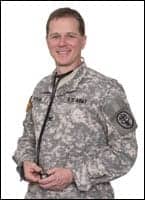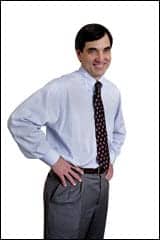 September marked 2 years that Edwin A. Lodgek (left) has been in place as senior vice president and general manager of Toshiba America Medical Systems (TAMS of Tustin, Calif). He joined TAMS after 18 years at the former Marconi Medical Systems, where his position was vice president for North America and he led a campaign that nearly doubled company sales from 1997–2001.
September marked 2 years that Edwin A. Lodgek (left) has been in place as senior vice president and general manager of Toshiba America Medical Systems (TAMS of Tustin, Calif). He joined TAMS after 18 years at the former Marconi Medical Systems, where his position was vice president for North America and he led a campaign that nearly doubled company sales from 1997–2001.
With 2 years under his belt at TAMS, Lodgek recently spoke with Medical Imaging magazine about his time at the company and the strategic plan he intends to enact.
Q. What have been your priorities during your first 2 years as general manager?
A. These 2 years have gone by rapidly. I took a look at the business and developed strategies to aggressively grow it. Our focus has been broad in scope, and we have invested in improving our top-line performance. We have supported [this mission] by some very significant changes in the leadership in our field organization. We also enhanced training programs for the sales organization and added support for the process relative to budget objectives and their tracking and accountability.
The other aspect has been the marketing and collateral support for that organization. Our parent company in Japan has a business structure that includes business units, which, in turn, represent the various modalities. In the United States, we did not have that structure, so I restructured our marketing organization and aligned with Japan with similar business units.
Now we have a business unit director for CT who is on the same plane as a business unit director in Japan, where they are communicating about the product road map, plans, and requirements of our marketplace here in the United States as well as the applications of the products. This [new business unit] is helping us better position for the pipeline of products necessary to support the aggressive growth plans I mentioned.
Q. With that in mind, which medical imaging modalities will Toshiba emphasize in its short-term and long-term plans?
A. The flagship for our core plan and growth has been CT. We have exceeded market growth rates driven by a differentiated product with leading technology in detectors, the speed of our scanner, and the applications as a result of that speed—such as in cardiac and cardiovascular.
We also are very intent on growing our other imaging technologies, such as MR. We have a new platform we are about ready to release. It is the 1.5T [tesla MRI scanner] with a 1.4-m short-bore magnet. It will be called the Vantage. We have a new platform with an improved gradient package in our open magnet, the Ultra.
We have two new technologies in ultrasound with the Aplio and the Nemio. [Ultrasound technology] is a business that Toshiba has done well in around the world but has not been a significant factor in the United States. We have invested in the technology and in our sales and marketing efforts to change [this situation] rapidly. We are seeing results in growth rates for Toshiba ultrasound, which exceed market growth rates.
In the vascular and X-ray area, we maintain a heavy priority on flat-panel development. We have clinical testing ongoing at various sites, and we’re making excellent progress in digital subtraction, angiography, and R/F.
These are the key components of our operating plan and the products that will drive that growth.
Q. What is the timetable on the flat-panel technology?
A. We would expect to see flat panel within this fiscal year, which ends in March 2004. We are on a rapid track for development, so announcements could come quickly.
Q. What are Toshiba’s plans in nuclear medicine?
A. We have a partnership with a large provider of cameras and have expanded the offerings in the United States. We went from a dual-head camera system to a fixed dual-head system, as well as a single-head system. We are offering all three cameras in the United States.
We also continue with research and development in Japan for various applications for these products by way of software enhancement. At this point, that will be our direction for the foreseeable future in nuclear medicine.
Q. Much of the growth you outlined is driven internally. Are there plans for expansion through acquisition?
A. We look at external and internal development for enhancing our portfolio. Toshiba’s focus is more internal, where we have core competencies. There are many opportunities in modalities, such as CT, to enhance the technology and improve applications.
We continue to focus our investment in those modalities, as opposed to acquiring companies and other technologies. That’s not to say we don’t have other partnerships; we do. We are quite focused on making aggressive operating plans and in the development of core technologies and their applications, as opposed to the expense and some of the redundancies created by making acquisitions. Many times, we think it can dilute your effort rather than complement it.
Q. Following on that theme, which other Toshiba business units complement the medical division?
A. If one looks at semiconductors and liquid crystal, those device technologies are very important in the medical field to help realize the efficiencies, quality, and reliability of our sensor parts of diagnostic equipment. We are certainly benefiting by the strengths we have in Toshiba as a company. Toshiba is a $40 billion–plus worldwide company in many of these areas.
Q. Looking specifically at the US market, what are the growth plans for Toshiba?
A. The objective is to exceed the growth rates of the US market. For the last 2 years, we have been successful in doing so. In 2001 and 2002, we exceeded market growth rates in the United States by growing—just in sales revenues—by more than 20%. The market did not grow at that rate.
We had growth in CT of more than 50% in revenues, whereas the market grew, according to NEMA, in the neighborhood of 19%. In MR, we grew at 17%; the market grew at 7%. In ultrasound, we grew at 53%; the market grew at 7%.
Q. Let’s switch to the service side for a moment. What are Toshiba’s plans and priorities in this area?
A. Our strategic plan includes continuous improvement in customer satisfaction in the installed base and new installations. We want to achieve excellence for what we sell as opposed to diluting our service support by pursuing other equipment.
Having said that, we do have a health technical service group, which we will continue to develop as long as it applies to new commitments that support our core growth plan. Besides that, I have never been particularly impressed with the financials of multivendor service operations.
A very high priority for us is to be certain that the investment in our service keeps pace with the aggressive growth plans. We are growing our installed base very rapidly, and I want to make sure that the response time and the deployment of human resources are equal to the growth rate that we have. We won’t be successful if our customers are not happy with our service and support.
Q. Which technologies are missing from the product portfolio that Toshiba would like to add?
A. Our plan is to continue to look at other technologies, such as PET. Where we think it makes sense and is supportive of our longer-term plans, we will invest in the research and development, and, at some point, we may enter that market. We are investigating that plan very carefully.
Q. PET, of course, brings to mind molecular imaging and the great potential many health care professionals see there.
A. Without question, we believe that molecular imaging is an area that will continue to grow in importance and application. It is Toshiba’s intent to be there at the right time with a product we believe can meet the needs of the market. That does not mean, however, that partnering with an existing provider is the right thing for Toshiba to do at this point.
In Japan, the adoption of PET is at a slower pace than in the United States. It might make sense for Toshiba in Japan to take one approach and for Toshiba in the United States to take a different approach.





